
WEEDS: ERADICATING NOTHING BUT DOING SOMETHING
October 3, 2005
R.M. Dixon
As global desertification and warming advance, land barrenness becomes increasingly conspicuous. The absence of vegetative cover drastically affects the climate both locally and globally. Air temperature rises without the cooling effect of vegetation and evaporation from moist soil. The absence of vegetative cover also drastically affects the hydrologic cycle, especially at the soil surface. Rain falling on barren land smooths and seals the soil surface, blocking rainwater entry or infiltration thereby resulting in rampant shedding of rainwater with devastating downslope flooding and silting. Without infiltration, upland groundwater aquifers dry out, springs dry up and rivers disappear except for an occasional flash flood following rainstorms.
Meanwhile a plethora of concerned citizen groups are out doing their level best to eradicate weeds-exotic, noxious, obnoxious and otherwise-that in turn are doing their best to provide cover for the barren or near barren landscape. These weeds are the pioneers in the well-known natural succession of plant types. They pave the way by improving soil conditions for the next plant type in a sequence that may take 100 years or more in dry regions. Grasses are especially effective pioneers.
It seems obvious to the author that we should be eradicating nothing , but rather doing something to help these pioneer plants reclaim the barren or near barren landscape. Once reclaimed the landscape can provide the many services of flourishing late successional plant communities such as cool blue skies, fresh spring water and productive soils to name a few.
The something we should be doing is accelerating the natural plant succession beyond the weed or pioneer stage. Accelerating succession falls within the realm of restoration ecology.
To apply Albert Einstein's statement to weeds: No (weed) problem was ever solved at the same level of awareness at which it was created. Thus further land disturbances will never solve weed problems in the long run, however applying the principles of restoration ecology will provide not only effective weed control, but also a beneficial late successional ecosystem as well. Destructive weed control methods will only produce more weeds indefinitely into the future ensuring that those engaged in such practices will never be unemployed.
By using appropriate practices to accelerate succession, the century or more needed to complete the process naturally can be reduced to as little as a decade. Actual weed displacement may occur in just a few years.
Land imprinting does not eradicate weeds, but it suppresses them.
Imprinter mulching mesquite and creosotebush at Fort Stockton , TX .
Some ranchers in West Texas consider these to be weeds that compete with forage grasses
The Imprinting Foundation
1616 E. Lind Road
Tucson, AZ 85719Close Window to Return to List
If you entered our site on this page, click on Logo below to go to the Imprinting Foundation for more Information

